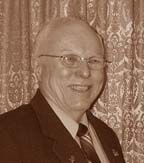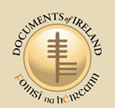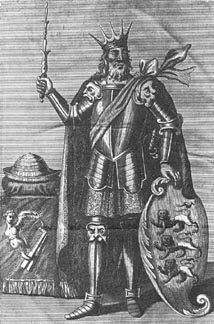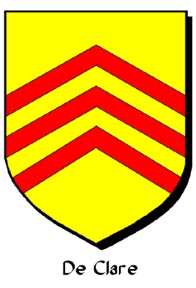| Click for
PDF index |
 This
page was set up by Robert Sewell in April 2006 to show the descent of the
Sewell Family from our ancient Irish ancestors. Robert Sewell graduated
from McMaster University (Hamilton, Ontario, Canada) in 1967 with a B.Sc.
degree in chemistry. After a year of studies at the University of
Toronto's College of Education, he taught high school science in Collingwood,
Ontario for a year and then taught chemistry, physics and general science
in Hamilton, Ontario for twenty-nine years. Robert Sewell retired
from teaching in June 1998.
This
page was set up by Robert Sewell in April 2006 to show the descent of the
Sewell Family from our ancient Irish ancestors. Robert Sewell graduated
from McMaster University (Hamilton, Ontario, Canada) in 1967 with a B.Sc.
degree in chemistry. After a year of studies at the University of
Toronto's College of Education, he taught high school science in Collingwood,
Ontario for a year and then taught chemistry, physics and general science
in Hamilton, Ontario for twenty-nine years. Robert Sewell retired
from teaching in June 1998.
Click to contact Robert Sewell
Please visit the Sewell Genealogy Site Map for other pages in this series.
| Click for
PDF index |
World Book Millenium 2000 Deluxe Edition,
© 1999 World Book Inc., © IBM Corp.
Microsoft Encarta Encyclopædia 99,
© 1993-1998 Microsoft Corporation
Norman F. Cantor (ed.) The Encyclopædia of
the Middle Ages, New York, 1999
Frederick Lewis Weis:
Ancestral Roots,
7th Edition, Baltimore, 1999
Celtic Ireland AD 400 - 1200, Time-Life
Books, Richmond, Virginia, 1998
Berhard Grun, The Timetables of History,
New York, 1991
J.C. Beckett, A Short History of Ireland,
London, 1979
Martin Wallace: A Short History of Ireland,
South Devon, 1973
The Book of History (18 Volumes), London,
1914
Richard Thomson: An Historical Essay on the
Magna Charta of King John (London, 1829)
Mediæval
History Guide,
http://historymedren.about.com/index.htm
Brian Tompsett, Royal Genealogical Data,
http://www3.dcs.hull.ac.uk/genealogy/royal/
CELT: Online Resource of Irish History, University
College Cork,
http://www.ucc.ie/celt/
Archives of University College Dublin,
http://www.ucd.ie/archives/
Ireland's History in Maps, http://www.rootsweb.com/~irlkik/ihm/iremaps.htm
Ancient Ireland was divided into about one hundred and fifty tiny kingdoms, each ruled over by a local king who was really just a tribal chieftain. There were also five main kingdoms: Ulster, Connacht, Leinster, Munster, and Meath.
Please click on Mediæval Ireland for more information
The Annals of the Kingdom of Ireland by the Four Masters (usually shortened to The Annals of the Four Masters) claim to record the History of Ireland beginning just prior to Noah’s Flood. The first entries in the Annals of the Four Masters are thought to date from about 550 AD; earlier (and perhaps later entries as well) must be considered to be partly legendary. However, we must be careful not to “throw the baby out with the bathwater” as these annals represent a unique view of the history of Ireland as recorded by someone who was 1500 years closer to the truth than we are in the 21st century.
The Annals of Inisfallen chronicle the history
of Ireland beginning 433 AD, but are believed to have been written between
the 12th and 15th centuries. The Annals of Ulster, beginning
431 AD, are thought to have been compiled in the late 15th century.
| "AOIS domhain gus an m-bliadhoin-si na dileand, da mhile
da chéad da fichet & da bhliadhoin.
"Ceathracha la ria n-dilinn tainig Ceasoir go h-Eirinn, go c-caogaid n-inghen, & go t-triar b-fer . . .." |
|
|
| "The Age of the World, to this Year of the Deluge, 2242.
"Forty days before the Deluge, Ceasair came to Ireland with fifty girls and three men . . .." |
| "Aois Criost, ceithre ched triocha a dó.
"Pattraic do theacht i n-Erinn an bliadhain-si, go ro gabh for baitseadh & beannachaigh Ereann, fiora mna, maca, & ingena, cénmótá uathadh na ro fhaomh baitsiodh na creideamh uadh, amhuil aisnedheas a bheatha." |
|
|
| "The Age of Christ, 432.
"Patrick came to Ireland this year, and proceeded to baptize and bless the Irish, men, women, sons, and daughters, except a few who did not consent to receive faith or baptism from him, as his Life relates." |
|
Please visit
The Annals of the Four Masters can be accessed at the Documents of Ireland, University College Cork. Click on their logo  |
University College Dublin Archives
|
| "The Age of Christ, 122.
"Cathaeir Mor, after having been three years king over Ireland, was slain by Conn, and the Luaighni of Teamhair, in the battle of Magh hAgha." |
|
|
|
|
| "The Age of Christ, 435.
"Breasal Bealach, son of Fiacha Aiceadh, son of Cathaeir Mor, died." |
|
|
|
|
| Perhaps Breasal Bealach was a descendant
of Cathaeir Mor; but many generations must be missing. This sort of inconsistancy
hasn’t detered enthusiatic family historians from claiming an unbroken
line from very early times in much the same manner as an unknown historian
claimed a descent for the early kings of Wessex from Biblical figures dating
back to Adam and Eve.
See the entry in The Anglo Saxon Chronicle for the year 854 AD for this legendary line.
|
| "Anno Domini .dcccc.34., alias .dcccc.35
"Cinaedh m. Coirpri, dux Nepotum Ceinnselaig, cum multis a Nordmannis interfectus est." |
|
|
| "AD 934 alias 935.
"Cinaed son of Cairpre, chief of Uí Chennselaigh, was killed with many others by Norsemen." |
|
|
| 1. Cinaed macCairpre King of Ui Chennselaig, died in 935. |
| 2. Cellach macCinaeda, King of of Ui Chennselaig, died in 947 |
| 3. Domnall macCellaig, King of of Ui Chennselaig, died in 974 |
| 4. Diarmait macDomnaill, King of Ui Chennselaig, died in 996 |
| 5. Donnchad Máel nam Bó, King of Ui Chennselaig, died in 1006 |
6. Diarmait MacMáil nam Bó,
King of Ireland & Leinster. Died on February 7, 1072
Diarmait married to Darbforgaill ingen Donnchada O'Brien (died in 1080), a granddaughter of Brian Bórú. See Generation Three below for the continuation of this line. |
While Brian Bórú's ancestry depends solely on tradition and is not accepted as proven, we have two definite links with regard to his descendants.
This information is presented in Frederick Lewis Weis: Ancestral Roots, 7th Edition, Baltimore, 1999, pages 67, 69, 149 - 150, 202 - 203 and 224; and originates with material from:
|
This was the time of Brian Bórú, arguably
the only ard-rí (ARD-ree)
or
Please click on
|
 |
Generation One
Brian Bórú, High
King of Ireland
Born circa 941 at Béal Bórú (from
which he received his name), near Killaloe, County Clare, Ireland.
Died (murdered) on Good Friday, April 23, 1014.
Brian Bórú had at least three wives, one
of whom was Gormflaith of Naas, a daughter of Murchad, King of Leinster.
Brian Bórú and Gormflaith had a son:
|
|
Generation Two
Donnchad, son of Brian Bórú
and Gormflaith, King of Munster in 1023. Donnchad went on a pilgrimage
to Rome in 1064 and died the same year.
Donnchad had a daughter:
|
|
Slani, daughter of Brian Bórú
and an unknown wife. Slani married Sihtric of the Silken Beard, King of
Dublin who went on a pilgrimage to Rome in 1028 and died in 1042.
Slani and Sihtric had a son:
|
|
Generation Three
Darbforgaill ingen Donnchada O'Brien
Died in 1080
Darbforgaill married Diarmait MacMáil nam Bó, King of Ireland & Leinster. Diarmait was King of Leinster from 1042 to 1052, at which time he became High King of Ireland, a post which he held from 1052 until his death on February 7, 1072. When Dairmait became High King of Ireland in 1052, it appears that he resigned as King of Leinster and his son Murchad took over that post.
Darbforgaill and Diarmait had the following son:
|
|
Generation Four
Murchad macDiarmata macMáil,
King of Leinster 1052 - 1070
Died in Dublin, probably on December 8, 1070.
Murchad married to Sadb, a daughter of MacBricc and they had a son:
|
|
Generation Five
Donnchad macMurchada, King
of Leinster 1098 - 1115
Died, killed in battle against Domnall Ua Briain in 1115
Donnchad married to Orlaith and they had a son:
|
|
Generation Six
Diarmait Mac Murchada, King
of Leinster 1126 - 1171, also known as Dermot MacMurrough, is best remembered
for having brought the English to Ireland.
|
|
Generation Seven
Aoife (Eva) MacMurrough of Leinster,
Countess of Ireland
 |
|
to Richard "Strongbow" FitzGilbert de Clare, 2nd Earl of Pembroke. The above image indicates that the wedding must have been quite a striking social event. |
Click on Richard
"Strongbow" FitzGilbert de Clare for his background.
Aoife and "Strongbow" had the following children:
|
|
Generation Eight
Isabel de Clare, Countess
of Pembroke
Born about 1174
Died in 1220 and interred at Tintern Abbey
Isabel married in August 1189 at London, England to William
Marshal, 4th Earl of Pembroke, who was named in the Magna Charta as advisor
to King John. Click on William
Marshal for details.
Isabel and William Marshal had the following children:
|
|
Generation Nine
Lady Isabella Marshal
Born on October 9, 1200 at Pembroke Castle, Wales
Died during childbirth on January 17, 1240 at Berkhamsted
Castle, Hertfordshire and interred at Beaulieu Abbey, Hampshire
Lady Isabella married on October 9, 1217 at Tewkesbury
Abbey, Gloucester to her third cousin, Magna Charta Surety Gilbert de Clare,
4th Earl of Gloucester. Click on Gilbert
de Clare for details
Lady Isabella and Gilbert de Clare had the following
children:
|
|
Generation Ten
Isabel de Clare
Born on November 8, 1226
Died in 1254
Isabel de Clare married on May 12, 1240 to Robert le
Bruce, Lord of Annandale and they had a child:
|
|
Generation Eleven
Robert Bruce, Lord of Annandale
and Earl of Carrick
Died in 1304
Robert Bruce married in 1271, at Turnberry Castle to
Marjorie, Countess of Carrick and they had the following children:
|
|
For the continuation of this line, click on Robert the Bruce.
Please visit the Sewell Genealogy Site Map for other pages in this series.